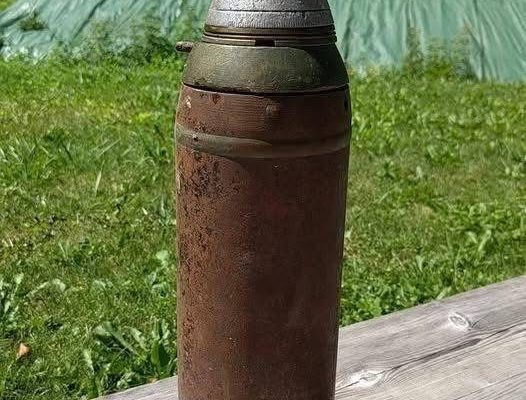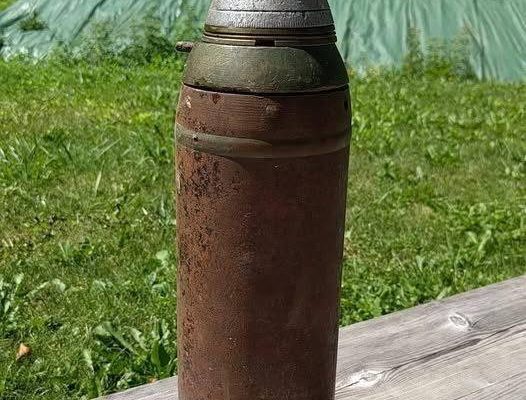y brother and I recently spent an afternoon exploring our grandpa’s garage, a place that felt like stepping into a time capsule. The garage was packed with dusty shelves, old jars filled with mysterious contents, rusty tools, and boxes piled high with forgotten keepsakes. Sunlight filtered through the grimy windows, casting a warm glow on the cluttered space. It was the kind of place where every item seemed to hold a story, and we were eager to uncover each one.
While rummaging through stacks of brittle newspapers and faded tin containers, we stumbled across something that made us pause. It was a heavy cylindrical metal object, coated in dust and rust, with faint markings etched along its surface and a sharp, pointed tip. At first, we weren’t sure what we were holding. Was it part of an old machine? A specialized tool? Its weight and build hinted at something more significant.
We turned it over carefully, squinting at the worn markings. After wiping away some grime, we spotted a date: 1915. Our curiosity intensified. This wasn’t just an old piece of scrap metal; it was something historical. But questions immediately followed—was it dangerous? Could it still be live? We weren’t about to take any chances without more information.
We set it gently on the workbench and snapped a few photos from multiple angles. A quick internet search revealed the answer: we had found an inert 1915-dated British 13-pounder shell. For those unfamiliar, these shells were widely used by the British Army during World War I. They were a crucial part of field artillery and played a significant role on the front lines.
The word ‘inert’ gave us an immediate sense of relief. It meant the shell had been disarmed and no longer posed any explosive danger. It was now nothing more than a historical artifact—a tangible piece of one of the most defining conflicts in modern history. Yet, despite knowing it was safe, holding it in our hands felt heavy with meaning. This was not just a piece of metal; it was a fragment of a global story.
The British QF 13-pounder field gun, which fired shells like the one we found, was an essential part of the Royal Horse Artillery during World War I. These artillery pieces were known for their mobility and rapid rate of fire, making them invaluable in both offensive and defensive operations. Every shell, including the one in our hands, carried with it a weight far beyond its physical mass.
We dove deeper into research and learned about the manufacturing process of these shells. Each one was meticulously crafted, stamped with identifying details such as the date of production, manufacturing location, and sometimes even the specific batch it belonged to. Our shell, with its 1915 date, was most likely produced during one of the war’s fiercest years.
But how did this relic end up in our grandpa’s garage? Was it a war souvenir brought home by a relative? Had it been purchased at an antique sale or passed down through generations without much thought to its historical significance? The story of how it arrived here may forever remain a mystery.
With utmost care, we cleaned the shell using gentle methods to avoid damaging its surface or markings. Once polished, we decided to place it on a sturdy wooden shelf in the garage, where it could be properly displayed. It now sits proudly among other relics and tools, a silent storyteller of a bygone era.
Finding the inert 1915 British 13-pounder shell was about more than just uncovering an old object—it was about connecting with history. It reminded us that history isn’t always locked away in museums or confined to dusty textbooks. Sometimes, it’s sitting quietly in a forgotten corner, waiting for someone to rediscover it.
Now, every time we visit the garage, our eyes are drawn to the shell on its shelf. It’s more than just a relic; it’s a bridge to the past, a reminder of resilience, and a symbol of the stories that objects can tell if we’re willing to listen closely. And every time we see it, we can’t help but feel grateful for the unexpected adventure of finding history right in our grandpa’s garage.



